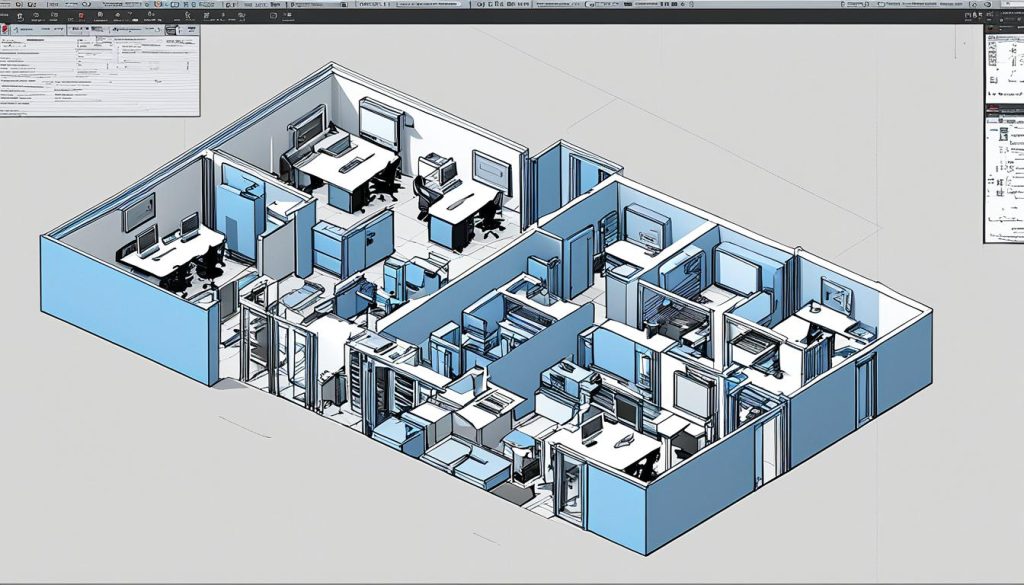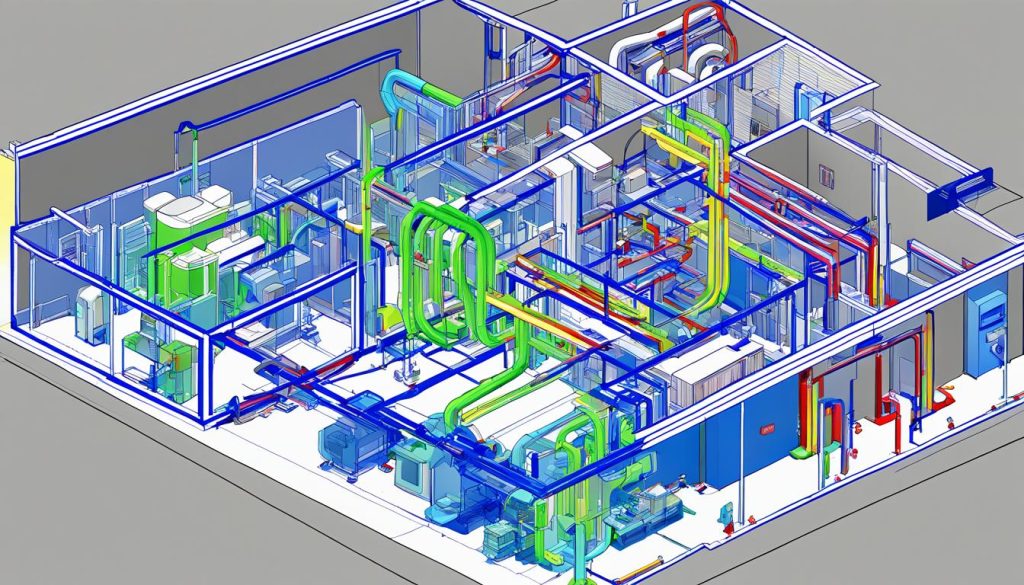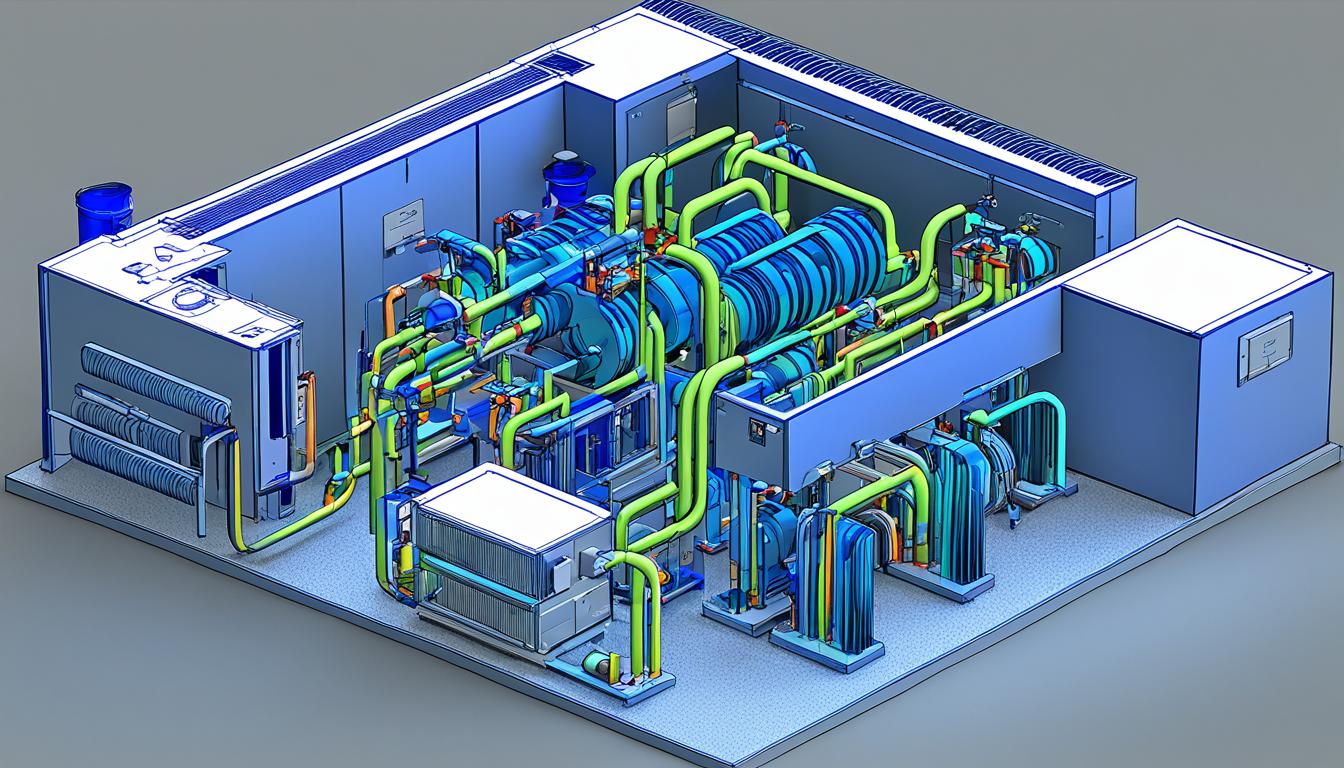Using 3D modeling in AutoCAD HVAC software helps spot and fix conflicts between building systems. This makes working together easier and improves project management. With advanced tools, you can make MEP systems work better, cut down on mistakes, and save time.
AutoCAD HVAC design uses strong 3D modeling to make detailed HVAC system models. These models are key for clash detection, which finds spatial issues. Adding these tools to your work makes the design smoother and keeps different parts of the building in sync.
Introduction to 3D Modeling in HVAC Design
3D modeling has changed HVAC design, making it more efficient and accurate. Now, you can see complex systems before they’re built, making the process smoother. This new method uses building information modeling (BIM) to make detailed, interactive models of HVAC systems.
With 3D design, you can find problems early, saving time and money. You can look at your HVAC system from all angles, making sure it’s placed right and works well. This helps avoid costly mistakes later on.
3D modeling also makes working together easier. Teams can edit the same model at the same time, sharing ideas and making changes quickly. This way, everyone works together better and mistakes are fewer.
| Aspect | 2D Design | 3D Modeling |
|---|---|---|
| Visualization | Limited | Comprehensive |
| Clash Detection | Manual, time-consuming | Automated, efficient |
| Collaboration | Sequential | Simultaneous |
| Changes | Difficult to implement | Easy to adjust |
Using 3D modeling in HVAC design puts you ahead in the industry. It lets you make HVAC systems that are more efficient, cost-effective, and reliable for your clients.
Understanding Clash Detection in Building Information Modeling (BIM)
Clash detection is key in Building Information Modeling (BIM). It spots conflicts in 3D models before building starts. This saves time, money, and avoids mistakes during construction.
Definition of Clash Detection
Clash detection finds when different parts in a 3D model share the same space. It’s vital for checking if building systems can work together without problems. This is very important in mechanical electrical plumbing (MEP) coordination.
Importance in HVAC Design
In HVAC design, clash detection stops buying extra materials and cuts down on surprise change orders. It helps in planning better and using space wisely. Spotting issues early lets you make smart choices that make the HVAC system work better.
Types of Clashes
There are three main clash types you should know:
- Hard Clashes: These happen when objects touch each other in the 3D model.
- Soft Clashes: These are about not having enough space or tolerance between objects.
- Workflow Clashes: These are scheduling problems that affect the building process.
| Clash Type | Description | Example |
|---|---|---|
| Hard Clash | Physical interference between elements | Ductwork intersecting with a beam |
| Soft Clash | Clearance or tolerance issues | Insufficient space for maintenance access |
| Workflow Clash | Scheduling conflicts | HVAC installation scheduled before wall framing |
Knowing about these clash types helps with better constructability analysis and MEP coordination in HVAC projects. This knowledge is key for making designs that work well, save time, and reduce mistakes during construction.
AutoCAD HVAC Software: An Overview
AutoCAD HVAC software is a powerful tool that combines AutoCAD’s versatility with HVAC design features. It lets you create detailed 3D models of HVAC systems. These models can be easily integrated with other building parts.
This software offers various 3D modeling techniques for HVAC design. You can use parametric modeling for flexible, adjustable components. Solid modeling is great for precise HVAC equipment representations.
AutoCAD HVAC software is great at performing clash detection. This feature helps spot and fix conflicts between HVAC parts and other building systems early on. This saves time and cuts down on costly mistakes.
| Feature | Description | Benefit |
|---|---|---|
| 3D Modeling | Create detailed 3D models of HVAC systems | Improved visualization and design accuracy |
| Clash Detection | Identify conflicts between HVAC and other systems | Reduced errors and construction delays |
| Parametric Components | Create flexible, adjustable HVAC components | Faster design iterations and modifications |
| Integration | Seamless integration with other building systems | Comprehensive building design and analysis |
The software supports both automated and manual clash detection. This gives you flexibility in your design process. With its wide range of tools, AutoCAD HVAC software makes the HVAC design process smoother. It goes from the initial concept to the final documentation easily.
Setting Up Your AutoCAD Environment for 3D HVAC Modeling
Getting your AutoCAD ready for 3D HVAC modeling is key. It helps with spatial coordination and finding clashes. You need to pick the right tools, set up your workspace, and bring in architectural models.
Required Tools and Add-ons
You’ll need certain tools and add-ons for better AutoCAD HVAC design. Fabrication CADmep is a must for making detailed 3D HVAC parts. It lets you model ductwork, piping, and equipment accurately.
| Tool/Add-on | Purpose |
|---|---|
| Fabrication CADmep | 3D HVAC component modeling |
| Navisworks | Advanced clash detection |
| MEP Modeler | Specialized MEP system design |
Configuring Workspace Settings
Customize your AutoCAD workspace for 3D modeling. Set up toolbars, palettes, and the command line for easy access to 3D tools. Also, tweak your display settings to make 3D objects clearer and help with spatial coordination.

Importing Architectural Models
Importing correct architectural models is crucial for clash detection. Use formats like IFC or DWG to bring in building structures. Make sure they align and scale right for accurate spatial coordination in your HVAC designs.
- Verify model accuracy before import
- Use reference points for proper alignment
- Check units and scale settings
Setting up your AutoCAD environment right makes 3D HVAC modeling smoother and more efficient. This is key for good spatial coordination and finding clashes in complex designs.
Creating 3D HVAC Components in AutoCAD
Creating 3D HVAC components in AutoCAD is key to your design process. By learning 3D modeling, you can make your HVAC systems come alive. This also helps with clash detection. Let’s see how to do this well.
Begin by using AutoCAD’s tools for ductwork, piping, and equipment. These tools help you make accurate HVAC system models. Make sure to focus on dimensions and properties for precise clash detection later.
Parametric modeling is a strong tool in AutoCAD HVAC design. It lets you make components that change with your design. This method saves time and boosts accuracy, especially for complex HVAC systems.
Essential HVAC Components to Model
- Ductwork: Create detailed 3D models of supply and return ducts
- Piping: Design accurate representations of chilled water and hot water pipes
- Equipment: Model air handlers, chillers, and boilers with precise dimensions
- Diffusers and grilles: Include these elements for a complete HVAC system model
Use layers wisely in your AutoCAD HVAC design. Group components by type or system for easier navigation and editing. This method also helps with clash detection by letting you focus on specific parts.
Mastering these 3D modeling techniques leads to better and more efficient HVAC designs. These detailed models are crucial for successful clash detection and project success.
Use 3D Modeling in AutoCAD for Clash Detection
3D modeling in AutoCAD is key for finding clashes in HVAC systems. It uses advanced tools to spot and fix spatial coordination issues early. This saves time and money later on.
Automated Clash Detection Tools
AutoCAD has powerful tools for finding clashes automatically. The Auto Clash Detection feature spots conflicts in real-time as you design. It checks your 3D model constantly, alerting you to clashes as they happen.
Manual Clash Detection Techniques
Even with automated tools, manual checks are still important. The DETECT command lets you check for clashes between objects. The CHECK command checks your whole drawing for conflicts.
Best Practices for Effective Clash Detection
Here are tips to make clash detection work better in HVAC projects:
- Keep your 3D model up to date with the latest changes
- Work closely with other teams for a complete check
- Use the 3DINSPECT command to see clashes between different objects
- Keep track of clashes and sort them out easily
- Have clear steps for dealing with and solving conflicts
| Clash Detection Method | Pros | Cons |
|---|---|---|
| Automated | Real-time detection, time-efficient | May miss complex spatial issues |
| Manual | Thorough, catches subtle conflicts | Time-consuming, requires expertise |
| Hybrid (Automated + Manual) | Comprehensive, balances efficiency and accuracy | Requires careful planning and execution |
Using both automated and manual methods together is best for HVAC designs. This mix ensures your 3D models look good and work well in real life.
Integrating MEP Systems in 3D Models
It’s key to bring together mechanical electrical plumbing (MEP) systems in 3D models for good spatial planning. This means combining HVAC, electrical, and plumbing parts into one architectural model. This way, you can spot clashes across all building systems easily.
Begin by adding each discipline’s models to your 3D space. This lets you see how different systems fit together in the building. Be sure to check where systems meet, like in utility rooms or under ceilings.
Use colors to tell MEP systems apart. For instance:
- Red for HVAC ductwork
- Blue for plumbing pipes
- Yellow for electrical conduits
This makes it easier to spot conflicts during planning. Don’t forget to add things like valves, switches, and panels. This makes sure the MEP systems are fully shown.
| MEP System | Key Components | Typical Clearance Requirements |
|---|---|---|
| HVAC | Ducts, AHUs, VAV boxes | 6-12 inches around ducts |
| Plumbing | Pipes, pumps, water heaters | 2-4 inches around pipes |
| Electrical | Conduits, panels, transformers | 3-6 inches around conduits |
Putting MEP systems together in your 3D model sets the stage for finding and fixing clashes. This makes design smoother, cuts down on site problems, and helps buildings run better.
Analyzing and Resolving Clashes in AutoCAD
For successful HVAC projects, it’s key to use effective clash detection methods. In AutoCAD, you can check and fix clashes to help with project teamwork. Let’s look at the main parts of this process.
Clash Reports and Visualization
AutoCAD makes detailed clash reports that show conflicts between HVAC parts and other building parts. These reports give important info on potential issues. They let you see clashes in the 3D model. By looking at these reports, you can spot trouble spots and start fixing them.

Strategies for Clash Resolution
Fixing clashes needs a step-by-step plan. You can use different strategies to solve conflicts:
- Redesign components to fit within available space
- Adjust layouts to improve system performance
- Change clearances to meet safety and accessibility needs
- Look for other ways to route ductwork and piping
Collaborative Clash Resolution Workflows
Working together is key to solving clashes well. Use workflows that bring together architects, structural engineers, and MEP experts. Tools like Navisworks Manage have advanced clash analysis and reporting features. This helps teams talk and make decisions better.
By using these clash detection methods and working together, you can make the HVAC design smoother. This also cuts down on expensive changes during building.
Advanced Techniques for 3D HVAC Modeling and Clash Detection
3D modeling has changed how we design HVAC systems. With new technologies, you can make clash detection better and make projects run smoother. Let’s look at some top strategies to improve your 3D HVAC modeling.
Smart clash detection software checks your model for problems all the time. This means you can fix issues right away, saving time and money. Adding info to each part helps solve conflicts better by giving details about each piece.
Adding construction steps to your 3D model shows when clashes might happen. This helps you solve problems before they start. Virtual reality lets you see clashes in a new way, making it easier to find and fix them.
| Advanced Technique | Benefits | Implementation Challenges |
|---|---|---|
| Intelligent Clash Detection | Real-time conflict identification | Software integration and training |
| Metadata Attachment | Detailed component information | Time-consuming data input |
| Construction Sequencing | Phase-specific clash prevention | Complex timeline coordination |
| Virtual Reality Walk-throughs | Immersive clash detection | Hardware and software costs |
Using these advanced 3D modeling and clash detection methods will make your HVAC design better. Keep up with new tech to stay ahead in the industry.
Case Studies: Successful HVAC Clash Detection Projects
A remarkable case study shows how 3D modeling and clash detection changed HVAC design. It was for a tall building, almost 200 feet high. The building had process equipment on five levels, making HVAC installation tricky.
3D modeling was key for working together on the project. It gave teams a detailed 3D model, saving months of planning. This made fitting in big equipment like a 32-foot water tank easier.
Constructability analysis was vital for the project’s success. The 3D model let teams plan the construction order before starting. This helped avoid clashes between HVAC parts and other systems, making installation smoother.
This case study proves the value of 3D modeling and clash detection in HVAC projects. Using these technologies improves teamwork, planning, and leads to smoother installations in complex buildings.





0 Comments